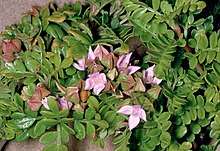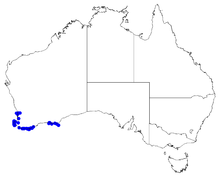Boronia alata
Boronia alata, also known as winged boronia, is a flowering shrub. It is an endemic species of Southwest Australia which has been introduced elsewhere as a cultivated plant.
| Winged boronia | |
|---|---|
 | |
| Boronia alata at Cape Naturaliste | |
| Scientific classification | |
| Kingdom: | Plantae |
| Clade: | Tracheophytes |
| Clade: | Angiosperms |
| Clade: | Eudicots |
| Clade: | Rosids |
| Order: | Sapindales |
| Family: | Rutaceae |
| Genus: | Boronia |
| Species: | B. alata |
| Binomial name | |
| Boronia alata | |
 | |
| Occurrence data from Australasian Virtual Herbarium | |
| Synonyms[2] | |
| |
Description
Boronia alata is an erect shrub with many branches growing to a height and width of 2.5 m (8 ft) but in exposed areas, sometimes a prostrate shrub only 0.3 m (1 ft) high. The leaves are pinnate with usually between seven and thirteen leaflets and 15–65 mm (0.6–3 in) long and 10–40 mm (0.4–2 in) wide in outline. The petiole is 4–18 mm (0.2–0.7 in) long. The leaflets are elliptic to lance-shaped, glossy and dark green but paler on the lower side. The end leaflet is 5–20 mm (0.2–0.8 in) long and 1–7 mm (0.04–0.3 in) wide, the side leaflets 6–22 mm (0.2–0.9 in) long and 3–9 mm (0.1–0.4 in) wide. The flowers are pink or white and borne in large groups in a panicle on the ends of branches, sometimes also in upper leaf axils, on a peduncle 2–24 mm (0.08–0.9 in) long. The four sepals are narrow triangular, 2.5–3.5 mm (0.098–0.14 in) long and 0.5–1 mm (0.02–0.04 in) wide, the four petals 7–12 mm (0.3–0.5 in) long and 4–6 mm (0.16–0.24 in) wide. The eight stamens alternate in length, with those near the sepals longer than those near the petals. Flowering occurs from July to December and the fruit are hairy capsules 4–5 mm (0.16–0.20 in) long and 2–3 mm (0.079–0.12 in) wide.[3][4][5]
Taxonomy
The species was first formally described by James Edward Smith in 1807, based on a collection made by Archibald Menzies at King George Sound.[6] The common name winged boronia is cited in state and national floras, and as a horticultural alternative since its introduction to English hothouses.[5][6][7] The identification of varieties of this species by Ferdinand von Mueller was later revised to see the autonym Boronia alata Sm. var. alata cited as a synonym for Boronia alata.[8]
Distribution and habitat
The shrub occurs in Southwest Australia, with most records located at coastal areas. The disjunct records are from Esperance Plains, Jarrah Forest, Swan Coastal Plain and Warren biogeographic regions. The habitat is dense vegetation on sand at dunes and limestone cliffs.[4]
Use in horticulture
Boronia alata is cultivated as an ornamental plant. It is able to be propagated from cuttings. As with most boronias, a heavily shaded situation is preferred for this species. The persistent flowers first appear in the austral spring, in a boronia form that is more open and 'star shaped' than concave or cupped; these are usually pink or infrequently white in colour. The native conditions can be simulated by providing well drained sand, with deep mulch or sandstone sheets that maintain available moisture and protect roots from higher temperature.[5] The species was introduced to English gardens in 1824 as a small evergreen greenhouse specimen, flowering from May to July.[9] The scent of the flowers is slightly fragrant.[10] The vigour of its rootstock was recommended for grafting with Boronia pinnata for English enthusiasts.[11]
References
- Smith, James Edward (1807). "Characters of three new Species of Boronia". Transactions of the Linnean Society of London. 8: 282–285. doi:10.1111/j.1096-3642.1807.tb00312.x. ISSN 1945-9432.
- "Australian Plant Census - Boronia alata". Retrieved 14 March 2020.
- Duretto, Marco F. (1999). "Systematics of Boronia section Valvatae sensu lato (Rutaceae)" (PDF). Muelleria. 12 (1): 4–15. Retrieved 21 February 2019.
- "Boronia alata Sm. Winged Boronia". FloraBase. Western Australian Government Department of Parks and Wildlife.
- Wrigley, J.W.; Fagg, M.A. (2003). Australian native plants : cultivation, use in landscaping and propagation (5th ed.). Sydney: Reed New Holland. pp. ???. ISBN 1876334908.
- "APNI - Boronia alata". biodiversity.org.au. Retrieved 7 December 2018.
- McIntosh, Charles (1838). The greenhouse, hot house, and stove. W. S. Orr and co. p. 86. doi:10.5962/bhl.title.69578.
- "APNI - Boronia alata var. alata". biodiversity.org.au. Retrieved 7 December 2018.
- "Boronia". Annals of horticulture; and year-book of information on practical gardening. London: Charles Cox. 1850: 146.
- Loddiges, C., ed. (1832). "No. 1833 Boronia alata". The botanical cabinet :consisting of coloured delineations of plants, from all countries, with a short account of each, directions for management, &c. &c. London. 19.
- "The Gardeners' chronicle :a weekly illustrated journal of horticulture and allied subjects". 3. 19. [Gardeners Chronicle]. 1896: 213. Cite journal requires
|journal=(help)